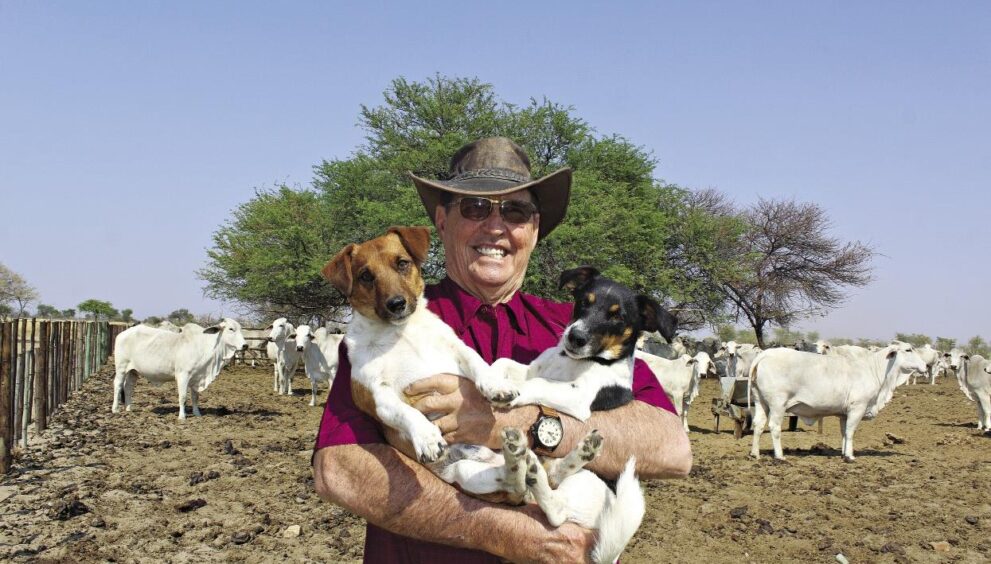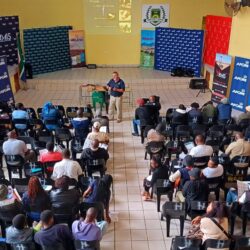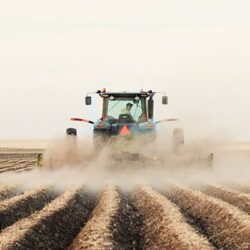Selection for field adaptation must be accompanied by accurate record-keeping. Rudi and Hugo Lemcke of Ghanzi in Botswana take this so far that they calculate the annual cost of every cow so they know when an animal is no longer pulling her weight.
Two factors have brought about a significant improvement in condition on Lemcke Ranches. Selecting cattle for adaptation and clearing the farms have been crucial in helping Rudi achieve his goal of weaning 10 000 calves annually.
They use an accounting system they have developed over the years, first with pen and paper and now on a computer. In it, they record weaning weights, the number of animals per camp, and when they were vaccinated and branded.
Ample grazing is the biggest contributing factor to the improvement in condition, Rudi explains. This is coupled with developing the farms by dividing them into smaller camps. They follow a four-camp system and keep 130 cows per camp to fully use the veld.
Rudi and his son, Hugo, own six stud farms consisting of 1 000 Brahman, 700 Simmental, 350 Simbra, 300 Droughtmaster, 100 Charolais and 80 Braunvieh cows. They also farm with 7 000 commercial cows. As the farming operation continues to grow, they recently purchased another 11 000 hectares northwest of Ghanzi.
In such a large operation, it is important to keep expenses under control. They are so cost-oriented that they calculate exactly what a cow costs them throughout the year. Rudi says they take all farming costs into account, such as salaries, fuel, supplements, veterinary expenses, maintenance, infrastructure repairs and bulls that are bought.
“As soon as a cow doesn’t become pregnant again, it’s a sign that she is too old or has become infertile. Then she is culled. We also cull cows that lose too much condition while raising their calves.”
The current average annual cost of a cow is R2 225. “That’s why it is so important that each cow is productive. If you have 20-30% of cows that are not pulling their weight, it is counterproductive for the farming operation,” says Rudi.
A cow’s annual cost on the farm averages R2 225, which includes infrastructure repairs, farm vehicles, wages, supplements and veterinary expenses.
SELECTION FOR CALVING PROBLEMS
Rudi says it has taken them at least 15 years to breed the right type: cattle with smooth hair and adapted to their environment.
Calves are the most important factor. A cow must be able to raise a good calf. Before weaning, workers watch each herd to identify weak calves and their mothers. They are then taken to another farm with their calves. There, the cows calve for the last time (they are already pregnant again), and once the new calves are weaned, they are culled.
The farming operation performs fertility tests on the cows and culls those that are not pregnant, replacing them with pregnant heifers. The bulls are tested for fertility every September.
Because the Lemckes have been strictly testing for fertility for a long time, there is not much difference between breeds. Those that were previously less fertile have greatly improved.
With selection, they have also sharply reduced calving problems. Cows now calve easily and newborns do not struggle to suckle. Thanks to strict selection, weak calves are now an exception.
The farm workers play an important role. Rudi and Hugo have groups of workers for different tasks and the cattle group works only with the cattle. There is also a group that builds and maintains infrastructure, and a group that makes and maintains firebreaks.
The cattle workers brand calves, wean them and vaccinate animals. They identify cattle that do not belong on the farm, such as cows with weak or ugly calves, and wild cattle that are difficult to work with. Those animals are slaughtered.
“The cattle managers play an important role. They are well-trained and visit all their cattle posts with a pickup every day to make sure everything is in order. They report sick or lame animals and bulls that are not covering the cows,” says Hugo.
Thanks to the eradication of invasive bushes, Rudi’s veld now has a carrying capacity of one cow per 8 ha. At the end of winter, there is usually still plenty of food left.
IMPROVE GRAZING
Improving the veld (grazing land) is also important. Rudi started combating invasive bushes in 2011 because they displace grasses. When he was a child, the carrying capacity was one cow per 10 ha but it gradually deteriorated to 1:25. Thanks to the eradication of invasive bushes, it is now 1:8. At the end of winter, there is usually still plenty of food left.
The beneficial climax grasses – Schmidtia, borseltjie, swartvoetjie and Smuts finger grass – have also increased.
Additionally, predators have moved away on their own, as they do not like open spaces. Previously, the Lemckes lost up to 300 calves a year to predators such as cheetahs, leopards, hyenas and wild dogs; now they hardly lose 30.
The farms are also thoroughly fenced for proper rotational grazing and management.
Rudi has replaced 98% of the diesel engines with solar pumps and positioned dams to make extensive use of gravity to let the water flow to the drinking troughs.
According to the Lemckes’ calculations, the solar systems they installed on boreholes paid for themselves within eight months. Each borehole has solar panels, and some have additional solar pumps that pump the water to other cattle posts.
SOLAR POWER FOR EVERYTHING
The farming operation relies on solar power, as it is not connected to the national power grid, even though power lines are within reach. Apart from farms that were recently acquired, all cattle posts have solar power stations. Installing them has taken many years. There are also generators at the cattle posts to drive water pumps when the sun is not shining.
The water was initially pumped with diesel engines that cost R26 400 at the time (R48 700 today). Diesel cost R8,35/litre at the time (now R22,25).
According to the Lemckes’ calculations, the borehole solar systems paid for themselves within eight months. Each borehole has solar panels and some also have solar pumps that pump the water to other cattle posts.
FERTILITY TESTING
Lemcke Ranches tests all the bulls annually for fertility, vibrio and brucellosis. Positive bulls are slaughtered.
Cows – stud and commercial – must calve every year, otherwise they are slaughtered and replaced with pregnant heifers. That is why they maintain a calving rate of more than 90%. As long as a cow calves annually, she stays in the herd, even when she becomes “middle-aged”.
A cow with an ugly calf (one that does not meet breed standards for conformation) is also slaughtered, even if she is an expensive stud animal. Those stud calves are sold with the commercial weaned calves.
The Lemckes select for growth at weaning by separating lean and fat calves. The lean ones go to their own feedlot at Hugo’s house. The fat calves grow out on the veld for another 18 months, after which lean calves and those with structural faults are culled.
They mix the rations for the feedlot themselves but buy all the supplements. They sometimes have the supplements tested at North-West University to ensure the composition is accurate according to the supplier’s claim.
Overall, the Lemckes are satisfied with the results. “We see it in our cattle’s good condition,” says Rudi.
The farming operation has its own trucks to transport cattle and haul supplements and farm equipment.
HONOURED FOR COMMUNITY WORK
The Lemckes provide permanent jobs for 400-500 people on their farms and businesses in Ghanzi. This excludes their businesses in Gaborone and other areas. However, there are 2 000 unemployed people in the village of D’kar near the farm where Hugo lives.
“We realised we need to invest in D’kar to gain the goodwill of the residents and avoid friction. We provided them with solar power and water and help uplift them by encouraging them to form dance, soccer and cultural groups.
“We build houses for the elderly, donate blankets in winter and provide game meat for the annual independence celebrations. In terms of education, we offer scholarships for children to attend school and university, support schools and donate equipment to high schools.”
Rudi recently received Botswana’s Presidential Award of Honour. It is awarded every five years to a citizen who has made an exceptional contribution in the social and economic fields. Rudi is believed to be the first farmer to be honoured in this way. He explains that many African farmers live hand-to-mouth and need to get good prices for their animals to survive. Governments and leaders in the livestock industry should therefore strive for an industry that ensures the smallest farmers can farm sustainably. This requires sufficient competition in markets, with enough abattoirs and buyers for their cattle.




